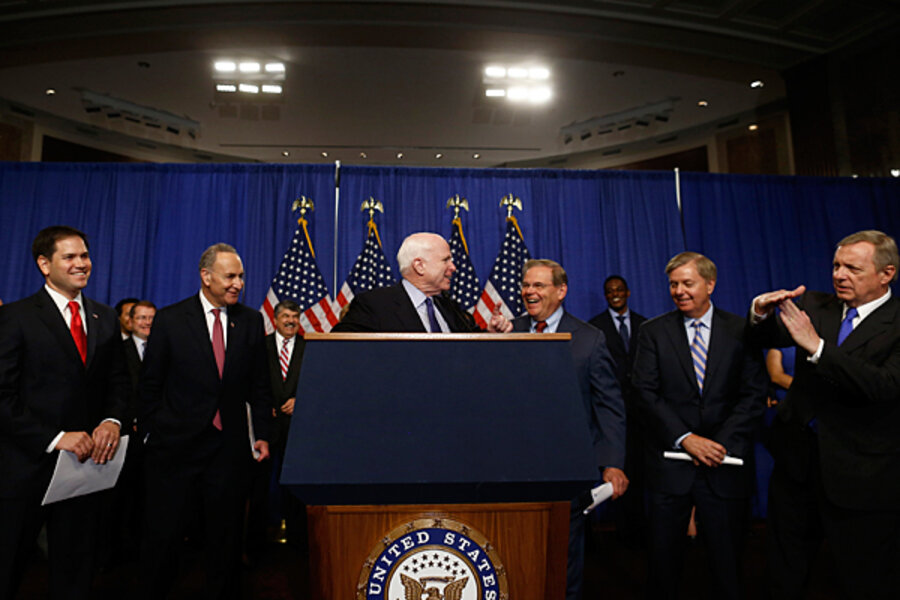US immigration reform: Why 'E-Verify' screenings, while flawed, will pass
Loading...
At the heart of immigration reform proposals in Congress is an idea that’s simple in concept but very difficult in practice: keep illegal workers from getting US jobs by conducting checkups on all the new hires at employers across America.
This idea of new-hire verification is highly popular. With 85 percent support from the US public, it is the most strongly supported of five basic elements of immigration reform, according to a February Gallup poll.
But the system, known as “E-Verify,” has shown plenty of flaws as well as promise in its early years of being available (but not widely required).
The problems: Many illegal immigrants slip through the cracks and win employment, while many legal workers face significant bureaucratic challenges – sometimes even losing their jobs because government databases deliver an erroneous “nonconfirmation” of their status.
Is E-Verify ready for prime time?
The short answer may be that, ready or not, here it comes. If a comprehensive immigration law passes Congress this year, many policy analysts say, it will include a provision to take E-Verify nationwide for all employers. On Friday the Senate began debating a comprehensive reform package, including the measure, formulated by the bipartisan "Gang of Eight."
To perfect E-Verify, the task ahead will be to keep improving and de-bugging the system, even as its use expands from about 7 percent of employers to all of them.
“Conservatives … have been pushing for a very, very long time” to implement E-Verify, says Philip Wolgin, an immigration policy expert at the liberal Center for American Progress. “Most people on the Democratic side, even if they aren't thrilled with it, understand that this is a necessary part of reform.”
The reason E-Verify is widely considered necessary is because the US workplace is in many ways central to the immigration challenge.
Tightening borders, by itself, won’t stop the flow of unauthorized people into the US if they can readily find jobs. And many conservatives in Congress will balk at granting legal status to millions who now work illegally – a central goal for proponents of comprehensive immigration reform – without strong workplace-level enforcement.
Against that backdrop, E-Verify is as crucial for politics as it is controversial in practice.
Here’s how the program works:
E-Verify is an Internet-based system that compares the information from an employee's Form I-9 (Employment Eligibility Verification) to data from the US Department of Homeland Security and Social Security Administration.
Many private sector employers voluntarily participate. All federal agencies have been required to use the program since 2007. Many states have laws mandating E-Verify for at least some employers. States that are implementing E-Verify for nearly all employers include Arizona, Georgia, Mississippi, and South Carolina.
When the databases for Social Security or immigration services (part of Homeland Security) don’t recognize a new employee, the employer gets a “tentative nonconfirmation,” or TNC notice. The employer is then legally obligated to tell the employee, who will have eight working days to contact the government to correct the record if possible.
If the worker fails to contest the TNC, or cannot correct the record, he or she gets a "final nonconfirmation." By law, employers are then expected to fire that worker.
More than 99 percent of the time, the databases provide a quick confirmation that a newly hired person is eligible. But sometimes the people who get a confirmation really shouldn't be eligible to work.
In February, Emily Tulli of the National Immigration Law Center told a congressional hearing that large numbers of illegal workers slip through E-Verify undetected. She cited 2008 research, finding that “54 percent of unauthorized workers for whom E-Verify checks were run were erroneously confirmed as being work-authorized.”
On the flip side, Ms. Tulli said, many legal workers find themselves flagged as potentially unauthorized.
One survey of 376 immigrant workers in Arizona, she said, found that more than 100 of them had been fired, apparently after the employer got TNC notices and failed to notify the workers about their opportunity to appeal.
“In fiscal year 2012, approximately 100,000 workers [nationwide] likely received erroneous findings from the system and may have lost their jobs as a result,” Tulli said in her prepared testimony. That number of people who lose their jobs in error could rise as high as 770,000 or more if E-Verify is mandated nationwide, she warned.
But Mr. Wolgin of the Center for American Progress says a worst-case outcome – with many people wrongly losing jobs even as hordes of unauthorized workers skate by undetected – is far from inevitable.
“This [Senate] bill actually has a lot of protections written into it,” he says.
For workers who are legal but get dinged with a TNC, it would provide new pathways for appeal if their initial efforts to correct the record aren’t successful, he says.
To better catch illegal workers, the bill now being considered by the Senate cracks down on ID fraud – an important reason why many illegal workers can slip through E-Verify undetected. It seeks to match photos presented by newly hired workers with photos in federal (passport) or state (driver’s license) databases.
The Senate legislation pairs E-Verify with legalization for millions of immigrants who are currently not authorized to work. That's important because it lightens the stress on E-Verify. The program might still face significant hurdles in ramping up to cover all US hiring, but the number of illegal workers to catch would be smaller.








